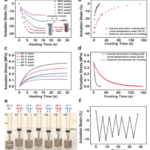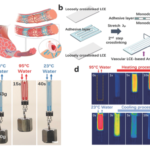Paper, Bioinspired Design of Vascular Artificial Muscle
Recently, liquid crystal elastomers (LCEs) have drawn much attention for its wide applications as artificial muscle in soft robotics, wearable devices, and biomedical engineering. One commonly adopted way to trigger deformation of LCEs is using embedded heating elements such as resistance heating wires and photothermal particles. To enable the material to recover to its unactuated state, passive and external cooling is often employed to lower the temperature, which is typically slow and environmentally sensitive. The slow and uncontrollable recovery speed of thermally driven artificial muscle often limits its applications when even moderate cyclic actuation rate is required. In this article, inspired by biology, a vascular LCE-based artificial muscle (VLAM) is designed and fabricated with internal fluidic channel in which the hot or cool water is injected to heat up or cool down the material to achieve fast actuation as well as recovery. It is demonstrated that the actuation stress, strain, and cyclic response rate of the VLAM are comparable to mammalian skeletal muscle. Because of the internal heating and cooling mechanism, VLAM shows a very robust actuating performance within a wide range of environmental temperatures. The VLAM designed in this article may also provide a convenient way to harvest waste heat to conduct mechanical work.
Learn about our two Decals!
 Click here to find out more about our Fall Bioinspired Design Decal and our Spring Bioinspired Design in Action Decal – ALL MAJORS are welcome.
Click here to find out more about our Fall Bioinspired Design Decal and our Spring Bioinspired Design in Action Decal – ALL MAJORS are welcome.Berkeley BioDesign Community
 Click here to learn about the BioD: Bio-Inspired Design @ Berkeley student organization or here to signup for more info.
Click here to learn about the BioD: Bio-Inspired Design @ Berkeley student organization or here to signup for more info.Search
Student Login





I imagine that the neurological circuits underlying these processes are governed by both 2d spacing maps with their brains as…
to reduce the impact of car accidents, it may be possible to study the force diverting physics of cockroaches to…
you see this type of head-bobbing stability in many avian creatures related to pigeons like chickens. the head ability to…
not like they taught horses how to run! this is an example of convergent evolution where both sea creatures and…
The brain functions in a similar way with neuronal connections. our brains are able to utilize the multiplicity of connections…